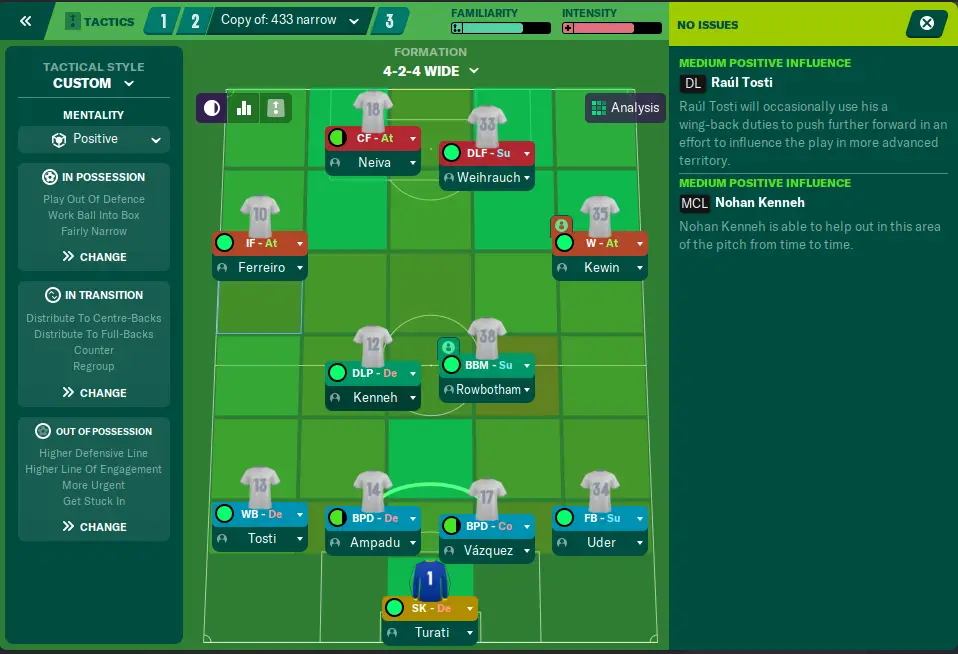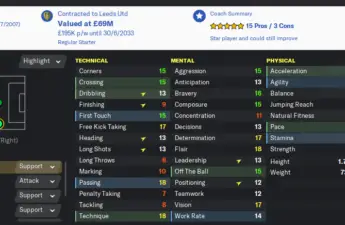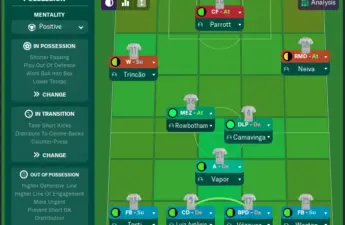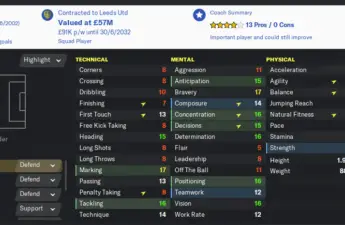A wing back is described in FM22 as a player who operates in the fullback position with no wing support ahead of him. He must therefore be able to fulfil both the attacking and defensive duties of wingers and fullbacks.
In attack, he must be able to run at his man and put in aggressive crosses, in midfield he helps win the possession battle and in defence, to close down opponents, block crosses and win the ball back when possible.
The role is available with four duties; defend, support, attack and automatic. The more aggressive you are in the duty you assign to the wing back role, the more his attacking prowess will be needed.
The game description states that the wing back operates without wing support since depending on the duty you give the wing back, he will be occupying spaces normally occupied by wingers while your team is in possession of the ball.
However, you can still have a player in the winger position as long as he is in a role like raumdeuter, inside forward or inverted winger that will demand the winger to cut inwards into the central areas of the pitch, opening the space in the wing for your wing back to move into while on an overlap.
Trent Alexander Arnold is arguably the best wing back in world football at the moment. Mohamed Salah operates in front of him, but they never occupy the same spaces as Salah primarily cuts inside to play a through ball to one of Firmino or Mane, or if the space opens up, he will take a shot on goal.
While in possession in the wide areas of central midfield, TAA is comfortable playing long balls to the opposite flank to find Robertson(another wing back on his own overlap). As he moves into the final third, TAA will then swing in early crosses into the box for the three frontmen to attack.
In narrow systems, Reece James is a good example of a wing back operating by himself on the flanks. In attack, he aggressively moves into the final third with the knowledge that he has the cover of three central defenders. This has led him to scoring quite a few goals for a player operating in a defensive position.
Once possession is lost, Reece James will then take his defensive position, slightly ahead of the three man backline, to prevent the opposition winger or wing back from advancing into the final third and swinging in crosses into the box.
Other players who can comfortably player the wing back role are;
- Giovanni Di Florenzo – Napoli
- Renan Lodi – Atlético Madrid
- Diogo Dalot – Man United
- Emerson Royal – Tottenham Hotspur
Attributes Required To Play As A Wing Back In Football Manager
Since the wing back will be spending most of the match running up and down the flanks, excellent physical attributes are a necessity. Therefore, aim for his acceleration, pace, stamina, and natural fitness to be at least 15. A high rating in these stats will make it easier for him to deal with the pace of the game. Natural fitness is not necessarily crucial, but it plays a huge role in the player recovering properly for the next match.
On the mental side, work rate is the most crucial stat for this role. You want your wing back to give his all on the pitch. Good off the ball movement is nice to have so that he can receive the ball in better places, but it is not crucial.
The technical side is where your wing back really needs to shine if he is to perform well in attack. Passing, crossing, dribbling and technique all need to be at least 15 if you want him to be consistently delivering good balls into the box. If you do not rely on crossing the ball into the box, you can get away with a lower attribute rating in crossing.
In addition to these, he must still be decent defensively to prevent your team from leaking goals from his side.
Player Traits Suitable For A Wing Back
The following player traits will nicely contribute to the wing back performing well;
- Gets forward whenever possible – The wing back role will benefit from a player whose natural inclination is to push forward into attacking areas of the pitch
- Tries long range passes – This player trait makes it more likely for the wing back to try more expansive passing, which might lead to attacking players taking advantage of a defence that has not yet regrouped following their own attack.
- Likes to switch ball to other flank – Switching the ball to the other flank might lead to finding an overlapping wing back or a winger totally unmarked, increasing the chances of the attack leading to a goal.
- Tries killer balls often – While not necessarily critical as the first three, a wing back who is capable of playing killer balls from out wide like Joao Cancelo or Trent Alexander Arnold adds a whole new angle to the attack.
Unsuitable Player Traits For A Wing Back
The following player traits will limit the effectiveness of a player operating as a wing back;
- Stays back at all times – This player trait can only be useful in the fullback position if you are using a role like the defensive fullback that plays no part in the attacking phase of your team.
- Plays short simple passes – It is not ideal having a wing back who is shy of trying risky passes, preferring to play simple side way passes that most of the time lead no where.
Football Manager Tactic With A Wing Back
As already mentioned, the wing back can work by himself down the flank or while also having a winger in front of him who will drift into central areas to open the wing for an overlap.

In the 4-2-4 system above, the wing back will primarily operate in the wide central areas of the pitch as he has the defend duty. This will ensure the two central midfielders are not overwhelmed by the opposition’s midfield players.
Occasionally, when it is safe to do, the wing back might move into the final third while the inside forward drifts into the box in search of goal scoring opportunities.
Kenneh, the central midfielder on the wing back’s side, is also in a less attacking role to offer some defensive cover on that side when the wing back inevitably moves forward into attacking positions.
On the other flank, the fullback is assigned the full back support role (less adventurous) since he has a winger in front of him who will hug the touchline and not open any space for overlaps. The fullback will also sometimes move forward into the wide areas of central midfield to present himself as a passing option.
If you fancy using inverted wing backs, you can check out this guide here, where I outline how I personally use them.


